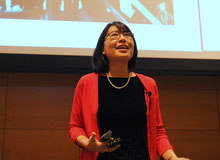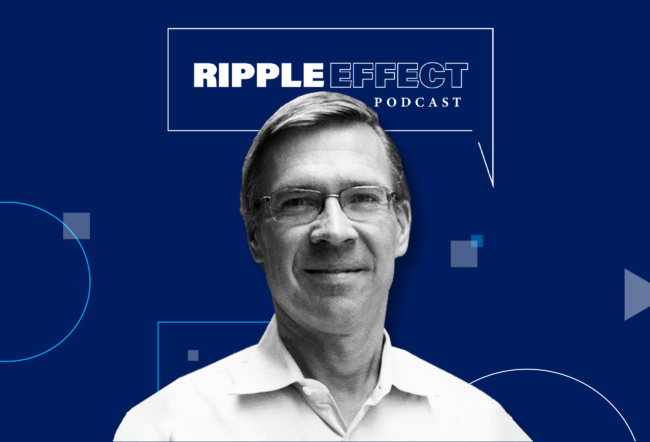Technology is transforming the world of philanthropy in ways that should ultimately give a voice to those people whom the charities aim to help, said Mari Kuraishi, co-founder and president of GlobalGiving, a 10-year-old nonprofit that connects donors with groups that manage charitable projects via the web. In a keynote speech at the recent Wharton Social Impact Conference, Kuraishi outlined the ways in which organizations are becoming more effective, and shared insights from the sometimes tough lessons she has learned along the way.
According to Kuraishi, the new model in philanthropy includes moves toward micro-donations and the ability to track how small projects are performing in the field. She had some advice for students who are on the path to becoming social entrepreneurs: Remain flexible. “The most important thing to me at least ten years down the road is that we have been able to adapt. By all means be passionate about the overall objective. But be really careful not to get too wedded to one strategy or another, or one particular manifestation of your product … because that will actually get in the way of pursuing the big, hairy, audacious goal that you have set for yourself.”
Founded in 2000 by Kuraishi and fellow World Bank veteran Dennis Whittle, GlobalGiving allows individual donors to use its website to find a project they would like to fund. Options include everything from helping to educate girls in Senegal to providing clean water to flood victims in Pakistan. Donations can be as little as $10 and donors get feedback from the people running those projects on how the money was used. The organization has collected $33 million from more than 120,000 donors and passed it along to 3,200 projects in 110 countries.
The path to that success was not exactly a straight one, however. Kuraishi and Whittle left the World Bank in 2000 with a vision for stoking innovation in the field of philanthropy through what she described as a “venture capital farm for international development.” At the time, the dot-com boom was at its peak and “everything [was] getting funded,” Kuraishi recalled. “[If] you had some pieces of paper with some lines on it, you got funded. And nobody had a business model. It was like, ‘Good idea — I’ll give you $10 million.'” In the frenzy of the time, Kuraishi said she wasn’t overly concerned about exactly how GlobalGiving would be structured. “We were heavily influenced by this era of ‘build it and they will come.'”
While the dot-com boom soon became the dot-com bust, Kuraishi and her team pressed on, spending two years developing a platform for the operation. That work, she said, was heavily influenced by a tagline once used to describe the company, an analogy that stuck: “Someone very early in our development called us the ‘eBay for international development,'” Kuraishi noted. “And we said, ‘Yes, that is what we are. We are trying to get buyers and sellers together.'”
While that tagline was a blessing because it made the company easily understandable to potential investors, it was also a curse. “When you start describing yourself as the eBay for development [even as you are in the middle] of designing [your system]… the eBay model begins to dominate every design decision you make,” she pointed out. Kuraishi’s warning to budding social entrepreneurs: Be careful when drawing those simple analogies. “When you are investing [or starting] something new, analogies are really, really important. But they unconsciously shape what you are thinking and saying both to outsiders and to your own team.”
In GlobalGiving’s case, organizers eventually realized that the eBay format wasn’t working. While it was easy to find good causes in need of financial help, the organization wasn’t attracting enough donors. In 2003, the team scrapped the consumer-focused platform and shifted gears to zero in on institutional partners who were already connected to donors. For example, GlobalGiving partnered with corporate giving programs at big companies like Hewlett-Packard, as well as with financial firms that offer donor advised funds.
That approach was humming along nicely in 2004 when an earthquake under the Indian Ocean triggered a series of tsunamis that devastated parts of Indonesia, Sri Lanka, India and Thailand. The disaster sparked a widespread outpouring of consumer donations to aid the impacted regions — and caused GlobalGiving executives to turn again toward a consumer-centric model. This time, however, Kuraishi’s team pursued that approach while also continuing to build the organization’s business-to-business operations. Six years later, b2b is the company’s primary focus.
But Kuraishi said the ability to shift direction based on new information is critical for any start-up. “It is really about feedback,” she told the audience. “What was so revolutionary about the web wasn’t that you could communicate at no cost over e-mail. It was the fact that you got [immediate] feedback. All these smartphones and iPads immediately give you feedback, and that process has gotten faster and faster.” According to Kuraishi, the generation now entering the workforce has adapted to this approach so completely that at times it frustrates Generation Xers like her. “Most of the people who work for me are Millennials,” she said. “My staff [are constantly asking questions like], ‘How did I do? What do you think?’ It kind of irritated me. Then I realized that they are actually smarter than I am because they are seeking feedback.” Her advice: “Don’t give up on your request for feedback. Annoy your boss by saying, ‘How’d I do? What do you think?’ It is what will make you succeed.”
A Solution to the ‘Dog Food Problem’
Kuraishi’s organization is embracing the explosion in readily available data and information. She believes it will be critical to addressing what she describes as the “dog food problem” — that is, that humans produce dog food and dogs consume it, but dogs can’t say what they like or dislike about the food. Kuraishi noted that this sort of “broken feedback loop” exists in charitable giving as well. While donors can get information from the organizers of charitable projects, it is rare for those funding a project to hear directly from the individuals who are actually being served by the effort. Much like direct consumer feedback via the web has transformed restaurant and hotel reviews through sites such as Yelp and TripAdvisor, GlobalGiving is trying to harness the power of the Internet to offer direct reports from individuals receiving aid.
“We are trying to set up something where the beneficiaries can report back to us and tell us how things are going, and tell the project leaders how things are going,” Kuraishi said. One experiment that GlobalGiving has done in this area focused on reaching out to people in Kenya, asking them to share stories about which charitable projects were working and which were not. That information was then linked to a map that allows potential donors to read reports from each location and sort them by topic, such as AIDS relief or assistance for women. “You can now take narratives and break them down into data and decide where you want to drill down,” Kuraishi noted. “That starts to give [a potential donor] a much better picture of what is going on in Kenya than [he or she] had before.” Ultimately, Kuraishi would like GlobalGiving to send questions directly to project beneficiaries via mobile phones, a strategy that would allow the company to gather larger volumes of consistent data about the effectiveness of the programs it supports. GlobalGiving will pilot such a system in 2011 in the Congo.
If GlobalGiving figures out how to gather the information and harness it effectively, Kuraishi plans to share the technology with other philanthropic organizations. “Imagine driving a car without a speedometer,” she told the audience. “The equivalent … is happening [in philanthropy] when you are not listening to your ultimate beneficiary voices.”
Walls and Bridges
Kuraishi’s career trajectory started with a trip to the Berlin wall she took as a high school senior. The visit fascinated Kuraishi in part because while tourists on the western side of the wall gawked at those on the eastern side, the East Berliners themselves never seemed to even look over the wall to the west. “People in East Berlin had trained themselves not to look over the wall,” Kuraishi said. “When I saw that I was like, ‘Wow, I have to get to the bottom of this.'”
Kuraishi, who speaks Russian, Italian, and French, earned a BA in history from Harvard and did graduate work in Russian and Japanese history and politics at Harvard and Georgetown Universities. With the fall of the Berlin wall and the disintegration of the Soviet Union, “My whole subject matter just exploded in front of me,” she recalled. Her father-in-law suggested that she talk to someone at the World Bank, which was looking for Russian specialists. That conversation led to a job — and a new direction.
Kuraishi believes the transformation of the 21st century giving model is just beginning. One of her dreams is that technology will eventually enable real-time requests for aid and equally speedy assists from donors — for example, near instantaneous help for a child in India needing $5 to cover the cost of his school lunch for a week. “I think that could transform the way you think about philanthropy. You could think ‘Oh I could give up my latte for three days and fund this kid’s school lunch….’ We will find ways to make philanthropy and other social engagement much more … satisfying than we have before.”
Also on Kuraishi’s wish list is a way to fund more daring projects. She said only five of the more than 3,000 projects that have been featured on GlobalGiving have had to be removed from the site due to concerns about whether the programs met the company’s standards. “That’s a pretty low failure rate,” she noted. “It suggests to me that we are being extremely cautious with risk.” While a more cautious approach to choosing projects makes sense because donors are disappointed when an effort they have funded ultimately fails, Kuraishi believes there is room for pushing the envelope. One possibility, she suggested, is for a marketplace to evolve that rates the risk of various projects and allows donors to select those that meet their risk tolerance. Using that strategy, some donors would likely support projects that, while risky, have a higher potential payoff.
Whether GlobalGiving is the organization to figure out how to make that next leap, or if someone else cracks that code, does not concern Kuraishi. “Does it really matter whether I get to the summit or if somebody else gets to the summit? I just want somebody to get there and it doesn’t have to be me. It would be gratifying from an ego perspective if it was me. But if I could help somebody else get there, then it is equally powerful.”



